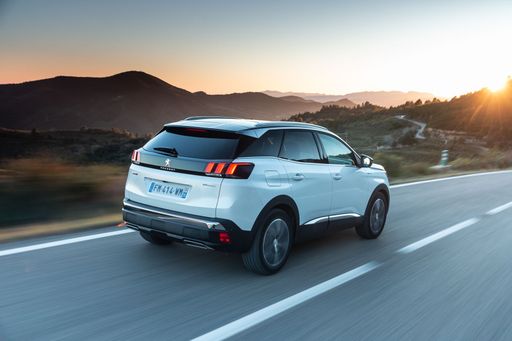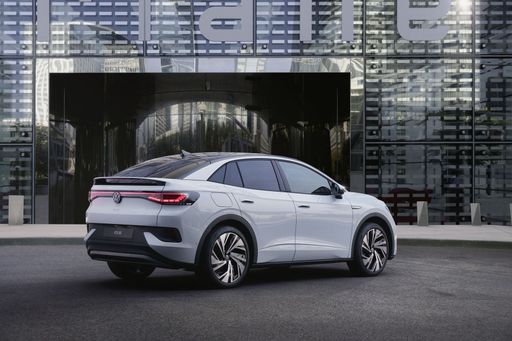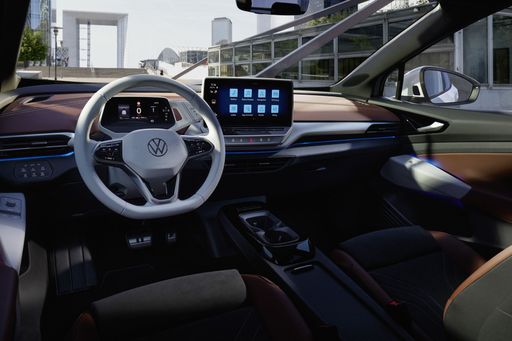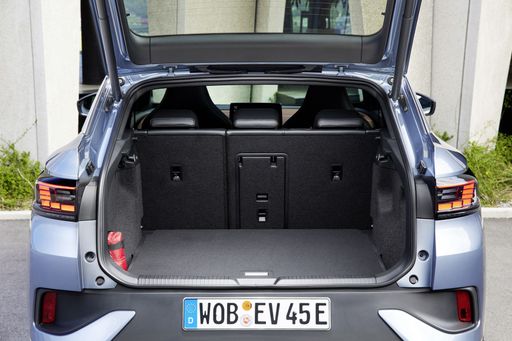Peugeot 3008 vs VW ID.5 - Differences and prices compared
Costs and Efficiency:
Price and efficiency are often the first things buyers look at. Here it becomes clear which model has the long-term edge – whether at the pump, the plug, or in purchase price.
Peugeot 3008 has a hardly perceptible advantage in terms of price – it starts at 35100 £, while the VW ID.5 costs 36800 £. That’s a price difference of around 1689 £.
In terms of energy consumption, the advantage goes to the VW ID.5: with 15.70 kWh per 100 km, it’s barely noticeable more efficient than the Peugeot 3008 with 16.90 kWh. That’s a difference of about 1.20 kWh.
As for range, the Peugeot 3008 performs slightly better – achieving up to 698 km, about 139 km more than the VW ID.5.
Engine and Performance:
Power, torque and acceleration say a lot about how a car feels on the road. This is where you see which model delivers more driving dynamics.
When it comes to engine power, the VW ID.5 has a barely noticeable edge – offering 340 HP compared to 325 HP. That’s roughly 15 HP more horsepower.
In acceleration from 0 to 100 km/h, the VW ID.5 is slightly quicker – completing the sprint in 5.40 s, while the Peugeot 3008 takes 6 s. That’s about 0.60 s faster.
In terms of top speed, the Peugeot 3008 performs somewhat better – reaching 220 km/h, while the VW ID.5 tops out at 180 km/h. The difference is around 40 km/h.
There’s also a difference in torque: VW ID.5 pulls distinct stronger with 679 Nm compared to 511 Nm. That’s about 168 Nm difference.
Space and Everyday Use:
Beyond pure performance, interior space and usability matter most in daily life. This is where you see which car is more practical and versatile.
Seats: offers more seating capacity – vs .
In curb weight, Peugeot 3008 is somewhat lighter – 1648 kg compared to 1963 kg. The difference is around 315 kg.
In terms of boot space, the VW ID.5 offers minimal more room – 549 L compared to 520 L. That’s a difference of about 29 L.
In maximum load capacity, the VW ID.5 performs hardly perceptible better – up to 1561 L, which is about 81 L more than the Peugeot 3008.
When it comes to payload, VW ID.5 a bit takes the win – 549 kg compared to 467 kg. That’s a difference of about 82 kg.
Who wins the race?
The Peugeot 3008 proves to be barely ahead and therefore becomes our DriveDuel Champion!
Peugeot 3008 is the better all-rounder in this comparison.
 @ Peugeot / Stellantis Media
@ Peugeot / Stellantis Media
Peugeot 3008
Costs and Consumption
View detailed analysis
Engine and Performance
View detailed analysis
Dimensions and Body
View detailed analysis
Peugeot 3008
The Peugeot 3008 blends bold French styling with a surprisingly grown-up interior that makes even dull commutes feel a little bit special. Practical enough for family life yet lively to drive, it’s a clever all‑rounder that stands out from the crossover crowd without shouting for attention.
details @ Peugeot / Stellantis Media
@ Peugeot / Stellantis Media
 @ Peugeot / Stellantis Media
@ Peugeot / Stellantis Media
 @ Peugeot / Stellantis Media
@ Peugeot / Stellantis Media
 @ Peugeot / Stellantis Media
@ Peugeot / Stellantis Media
VW ID.5
VW ID.5 dresses electric power in a sleek, coupe-like profile that turns sensible motoring into something a touch more stylish and smug. Inside it’s spacious and user-friendly, with calm, confidence-inspiring driving that suits buyers who want EV simplicity without the sci‑fi theatrics.
details @ Volkswagen AG / VW Media
@ Volkswagen AG / VW Media
 @ Volkswagen AG / VW Media
@ Volkswagen AG / VW Media
 @ Volkswagen AG / VW Media
@ Volkswagen AG / VW Media
 @ Volkswagen AG / VW Media
@ Volkswagen AG / VW Media
 @ Volkswagen AG / VW Media
@ Volkswagen AG / VW Media
 @ Volkswagen AG / VW Media
@ Volkswagen AG / VW Media
 @ Peugeot / Stellantis Media
@ Peugeot / Stellantis Media
|
 @ Volkswagen AG / VW Media
@ Volkswagen AG / VW Media
|
|
|
|
Costs and Consumption |
|
|---|---|
|
Price
35100 - 52000 £
|
Price
36800 - 48400 £
|
|
Consumption L/100km
2.4 - 5.4 L
|
Consumption L/100km
-
|
|
Consumption kWh/100km
16.9 - 17.6 kWh
|
Consumption kWh/100km
15.7 - 16.6 kWh
|
|
Electric Range
81 - 698 km
|
Electric Range
363 - 559 km
|
|
Battery Capacity
0.4 - 96.9 kWh
|
Battery Capacity
52 - 79 kWh
|
|
co2
0 - 121 g/km
|
co2
0 g/km
|
|
Fuel tank capacity
55 L
|
Fuel tank capacity
-
|
Dimensions and Body |
|
|---|---|
|
Body Type
SUV
|
Body Type
SUV
|
|
Seats
5
|
Seats
5
|
|
Doors
5
|
Doors
5
|
|
Curb weight
1648 - 2266 kg
|
Curb weight
1963 - 2233 kg
|
|
Trunk capacity
470 - 520 L
|
Trunk capacity
549 L
|
|
Length
4542 mm
|
Length
4582 - 4599 mm
|
|
Width
1895 mm
|
Width
1852 mm
|
|
Height
1641 mm
|
Height
1601 - 1618 mm
|
|
Max trunk capacity
1430 - 1480 L
|
Max trunk capacity
1561 L
|
|
Payload
432 - 467 kg
|
Payload
517 - 549 kg
|
Engine and Performance |
|
|---|---|
|
Engine Type
Electric, Petrol MHEV, Plugin Hybrid
|
Engine Type
Electric
|
|
Transmission
Automatic
|
Transmission
Automatic
|
|
Transmission Detail
Reduction Gearbox, Dual-Clutch Automatic
|
Transmission Detail
Reduction Gearbox
|
|
Drive Type
Front-Wheel Drive, All-Wheel Drive
|
Drive Type
Rear-Wheel Drive, All-Wheel Drive
|
|
Power HP
145 - 325 HP
|
Power HP
170 - 340 HP
|
|
Acceleration 0-100km/h
6 - 10.2 s
|
Acceleration 0-100km/h
5.4 - 8.9 s
|
|
Max Speed
170 - 220 km/h
|
Max Speed
160 - 180 km/h
|
|
Torque
230 - 511 Nm
|
Torque
310 - 679 Nm
|
|
Number of Cylinders
3 - 4
|
Number of Cylinders
-
|
|
Power kW
107 - 239 kW
|
Power kW
125 - 250 kW
|
|
Engine capacity
1199 - 1598 cm3
|
Engine capacity
-
|
General |
|
|---|---|
|
Model Year
2024 - 2025
|
Model Year
2024 - 2025
|
|
CO2 Efficiency Class
A, D, B
|
CO2 Efficiency Class
A
|
|
Brand
Peugeot
|
Brand
VW
|
What drive types are available for the Peugeot 3008?
The Peugeot 3008 is offered with Front-Wheel Drive or All-Wheel Drive.
The prices and data displayed are estimates based on German list prices and may vary by country. This information is not legally binding.
